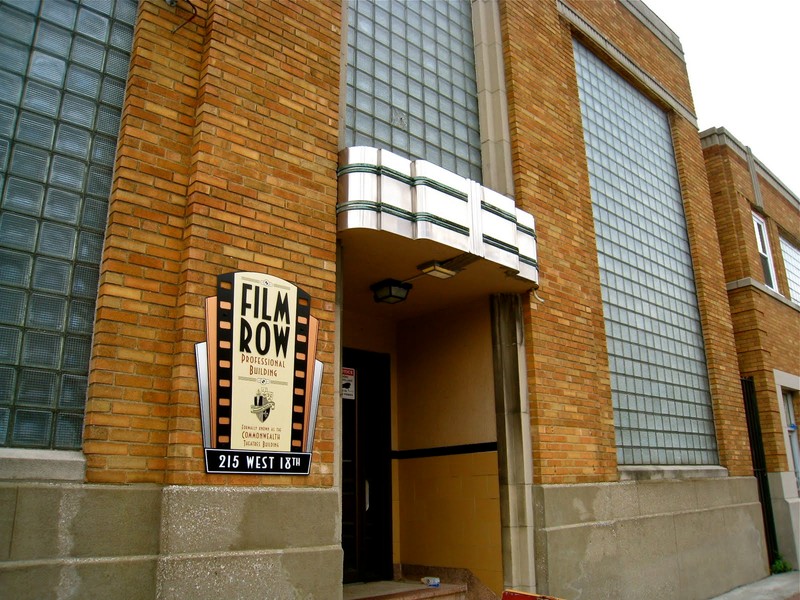Commonwealth Theaters Headquarters Building and Kansas City's Film Row
Introduction
Text-to-speech Audio
Kansas City's Film Row spanned four city blocks which included nearly twenty buildings that supported the production and distribution of films from Paramount, MGM, Warner Brothers, Paramount, and many others. Today, Kansas City’s Film Row is known as the one of the “most intact Film Row districts” in the United States.
Images
Kansas City's Film Row Historical Marker

Kansas City's Film Row Historical Marker

Backstory and Context
Text-to-speech Audio
Commonwealth Theaters, Inc. was a movie theater chain based in Kansas City. Its headquarters were purchased in 1936 as part of Film Row. Over the course of five decades, the company was bought and sold several times. In 1983, the company went private after a merger with CMN Capital Corp. The following year, it was reportedly one of the largest movie theater chains in the United States. By 1986, a film production company called Cannon Group Inc. purchased the company. The chief operating officer rationalized the purchase by saying: “If you make films, it is rather smart to have a place to show them.”
Two years later in 1988, Cannon sold Commonwealth to the Denver-based company United Artists Communications for $72.5 million. At this point, Colorado had 169 Commonwealth theaters and United Artists was the largest movie theater operator in the United States as well as one of the largest cable television companies. The building closed and the company went defunct by 1991.
This was only one building to occupy Kansas City’s Film Row. Taking up four square blocks between 17th and 19th streets from the 1920’s to the 1960’s, Film Row (now known as the Crossroads Arts District) served as a distribution point for the film industry. In these buildings, film canisters were stored before being distributed to New York and Hollywood. They stored and distributed films from Paramount, MGM, Warner Bros., Disney, Universal, and more. These buildings even housed the Manley Popcorn Company.
The need for a distribution point arose during the 1940’s and before television due to the vast amount of films being made at the time. There were more films being made every year between the 1920’s and 1960’s than is typically made in a year today. Kansas City was chosen as a distribution point in part because of its location at the center of the country. It also had strong railroad connections which was useful because the film canisters were transported by train. This specific block in Kansas City was chosen because municipal laws had been enacted in that area which determined how the buildings were built and fireproofed, which protected the buildings from damage should any of the highly flammable film rolls catch fire. The location was convenient as well - if film was damaged, it was easy to send them off to Ottawa, Kansas for repairs.
Film Row began losing its purpose as technological improvements were being made. The most influential factor in the downfall of Film Row was the digitization of film - there is no need to store film when movies are now being transported on hard drives through the mail.
Cite This Entry
Admin, Clio and Sarah Herndon. "Commonwealth Theaters Headquarters Building and Kansas City's Film Row." Clio: Your Guide to History. September 1, 2022. Accessed April 13, 2025. https://theclio.com/tour/2305/22
Sources
Rigby sells Commonwealth building, Kansas City Business Journal . April 16th, 2007. Accessed August 30th, 2022. https://www.bizjournals.com/kansascity/stories/2007/04/16/daily3.html?jst=b_ln_hl.
Film Row, Historic Kansas City. Accessed August 30th, 2022. https://www.historickansascity.org/historic/film-row/.
Dennis, Clarence. curiousKC | Kansas City's Crossroads has a Historic Tie to Hollywood, Flatland. June 6th, 2022. Accessed August 30th, 2022. https://flatlandkc.org/curiouskc/kansas-city-film-row-links-crossroads-arts-district-to-hollywood/.
Film History of the Crossroads District, VisitKC. Accessed August 30th, 2022. https://www.visitkc.com/filmtourism/self-guided-tour/crossroads.
Delugach, Al. United Artists Enters Theater Deal : Denver Firm to Form Venture With Cannon Affiliate, Los Angeles Times. February 11th, 1988. Accessed September 1st, 2022. https://www.latimes.com/archives/la-xpm-1988-02-11-fi-41907-story.html.
United Artists Buys Theaters, Lawrence Journal-World. August 1st, 1988. Accessed September 1st, 2022. https://news.google.com/newspapers?id=kqtAAAAAIBAJ&sjid=vOYFAAAAIBAJ&pg=5454%2C70419.
Fabrikant, Geraldine. Cannon to Buy Chain of Theaters, The New York Times. May 8th, 1986. Accessed September 1st, 2022. https://www.nytimes.com/1986/05/08/business/cannon-to-buy-chain-of-theaters.html.
Photo from Google Maps
Historic Kansas City

